Kodak Vest Pocket Model B
I was recently given this Kodak Vest Pocket Model B folding camera. The gift was from my parents but they do not remember where it came from. The best guess is that it was in a shipment of stuff from my grandmother sent from England in the 1970s and that most probably it was her camera.
These cameras were made from 1925 to 1934 which fits nicely with the years my grandmother was back and forth several times to India (one of my uncles was born there in 1927; my father in England in 1929. My grandfather, whom she met in India in the early 1920s and married in 1926, was stationed there into the early 1930s). Some sources say the Vest Pocket Model B did not include the autographic feature after 1930.
This camera is in excellent condition. It has the original canvas case slightly worn, and while a bit dusty (I did not clean it before taking this photos) and with very small oxidation around metal parts and a bit of rubbing it is in remarkably good condition considering it is 80 to 90 years old. In many respects it is a beautiful object as I hope you will see in the photos in this post. The camera is very small (in outline it is smaller than my Samsung s4 cell phone, though about 2.5 times as thick), especially for its time and is thus ideal for travelling. Not only does it fit in a vest pocket nicely, it easily fits in a purse as well. So, I think it is my grandmother’s camera, but I will probably never be certain.
This is an autographic model of camera, one that allows marking the negatives with a short note between shots, but I know of no negatives in the family collection that have been marked this way. If we do find negatives of the right size with her handwritten notations, then perhaps we can be more certain it was her camera. The stylus was intended to be used to open the autographic slot on the back of the camera, and it is clear from the scratches around the knob in the slot that this was done quite often and thus there should be negatives from this camera that are autographed, somewhere.
.
The camera uses 127 roll film, which as far as I can tell recently went out of production with the closure of the Fotokemika factory in Croatia, makers of Efke brand film, as well as some of Macophoto and Jessops films. There are on-line rumours that other companies are going to start making film in this size, but nothing seems certain at this time. At least one company is cutting down 120 film into this format from film made by other manufacturers. In any case, my local used camera store had three rolls of Efke 127 ISO100 film when I was first looking a couple of months ago. After confirming that my lab can process 127 film, I have bought one of the three rolls and will be running it through this camera once I have given it a good cleaning, and when lighting conditions are ideal.
The Vest Pocket B makes 4×6.5cm negatives, but 0.5 or so of that was dedicated to the autographic feature so the exposed negative is 4x6cm which is at the smallest end of the medium format size range (the most common medium format film is 120 and it is 6cm wide by varying lengths depending on the camera). Autographic film was wrapped with a thinner than usual backing paper with carbon paper sandwiched next to the film – these papers could be scored through by writing with a metal stylus in a gap that opens in the back of the camera, and then exposing the open gap to bright light for a few seconds. This scored marking on the papers leaked light through onto one margin of the negative, branding it permanently with the original form of EXIF data. It is an ingenious system, but was not very popular and Kodak stopped producing autographic film in 1932. The stylus for marking the film is held by friction in two slots to one side of the side of the lens. The knob in the sliding cover on the back of the camera has a hole in it for the tip of the stylus.
.
.
This camera has one shutter speed on the “I” setting (Instantaneous), as well as a “T” (Time) setting where the shutter stays open until it the shutter release is pressed again. The shutter release fires the shutter both when clicked downwards and upwards. Others have tested, or at least published, that the shutter speed is 1/25th of a second. My local camera store could not get a reading of the speed since the f-stop is small and does not let enough light through to test it. However, the guy helping me said it looks to be about 1/30th (I had not found the info at that time about it being 1/25th) and when I compared it to a couple of cameras at home, I have to agree that it is around 1/30th. I will treat it as 1/25th for exposure calculations, not that it makes any real difference if it were 1/30th.
.
The aperture has four positions, marked unhelpfully as 1, 2, 3, and 4. They are set by rotating a dial on the side of the lens casing, which moves different sized holes in front of the camera. On-line sources suggests that these correspond roughly to f11, f16, f22 and f32.
.
Focusing is fixed – the bellows extend to one position that they click into when the camera is opened properly. At aperture 1, the camera focuses from 7.5 feet to infinity, 2 is 6.33 feet to infinity, 3 is 5 feet to infinity and 4 is 4 feet to infinity.
.
Framing the photo is done by looking down on a view finder lens. The viewfinder can be rotated 90 degrees for landscape and portrait orientations.
.
The outside of the plate upon which the lens slides out has a tripod attachment, seen as a hole that goes through into the folded up camera.
.
To load film the whole front plate including the lens and bellows unit lifts out of the camera body, exposing the hollow back and slots for the film spools. The winding knob pulls out to release the film spool. Once the film is in place, the front of the camera is re-attached, the film advanced to the first frame and shooting can begin. At the end of the roll, the film and it’s paper backing have wound onto the take-up spool, which can be removed from the camera and sent for processing.
.
The Sunny 16 rule suggests that I can just get away with using ISO100 film on a sunny day, shooting at f32. The camera manual which by inference appears to have been written for ~ISO12 film, makes it clear that shooting in shade on a bright day is where this camera performs best, and the camera should be shaded with the sun behind or over the shoulder of the photographer to avoid lens flare.
I am guessing that this camera probably takes decent pictures when they are taken with care in just the right conditions. I am looking forward to giving it a try, and hope that the lens is clean enough and there are no light leaks, or any of the other myriad of confounding conditions that come into play with old cameras. I will use a light meter to be sure of the exposure, keep my back to the sun, shoot when it is bright with soft shadows but not brighter, try to keep it in the f16 to f22 range as being most likely the sweet spot for the lens. There are only 8 exposures on the roll of film. If I get a couple of decent shots, I will feel like I am did OK. I have got the materials I need to make a negative holder for my scanner as they don’t come this size. I probably won’t use it again since film is hard to get hold of, and expensive, and the camera is quite limited in its simplicity. But it will be fun to try, and who knows, it might take good pictures and I might get hooked on the idea of a pocket-sized ‘medium format’ camera. And a camera where it is so easy to make double exposures, or multiple exposures with partial advances of the film. Hmm, now that I think about it …..
Wish me luck, it feels a bit like an adventure to make this thing go.
EDIT: see this post for the results.
.
To open the gallery below, which has a lot more photos, click on any image, navigate with the arrows and escape to return to this page.
If you are on a mobile device and only one image opens at a time, then you are not properly in the post but rather are trapped in a WP Reader purgatory. You need to tap on the post title to open the post properly and then find your way back to here and try again.
- Unfolded, right side
- Unfolded, left side
- Open, but not extended
- Open but not extended
- Unfolded from front
- Aperture 1 (approx f11)
- Aperture 2 ( approx f16)
- Aperture 3 (approx f22)
- Aperture 4 (approx f32)
- Aperture animation
- Detail back of camera 1
- Detail back of camera 2
- Viewfinder animation for landscape and portrait orientation
- Stylus detail in storage loops
- Stylus with camera back, autographic slot open
- Autographic slot open detail
- Autographic slot closed detail. Note scratches.
- Autographic slot animation
- Camera opened up for inserting film
- World patent stamps inside back of camera
- USA patent stamps inside back of camera
- Film advance knob pulled up to release film spool.
- Back of camera, autographic slot closed
- Back of camera, autographic slot open.
- Front of closed camera. Note tripod mount hole.
- Front of camera, closed
- Edge of camera with winding knob.
- Edge of camera.
- Detail of end of camera.
- Camera in its original canvas case with leather strap.
.
.
.
.
Canon 5Dii, Canon 50/1.4 lens, f1.4-f2.0, 1/60th – 1/40th, natural light, hand-held







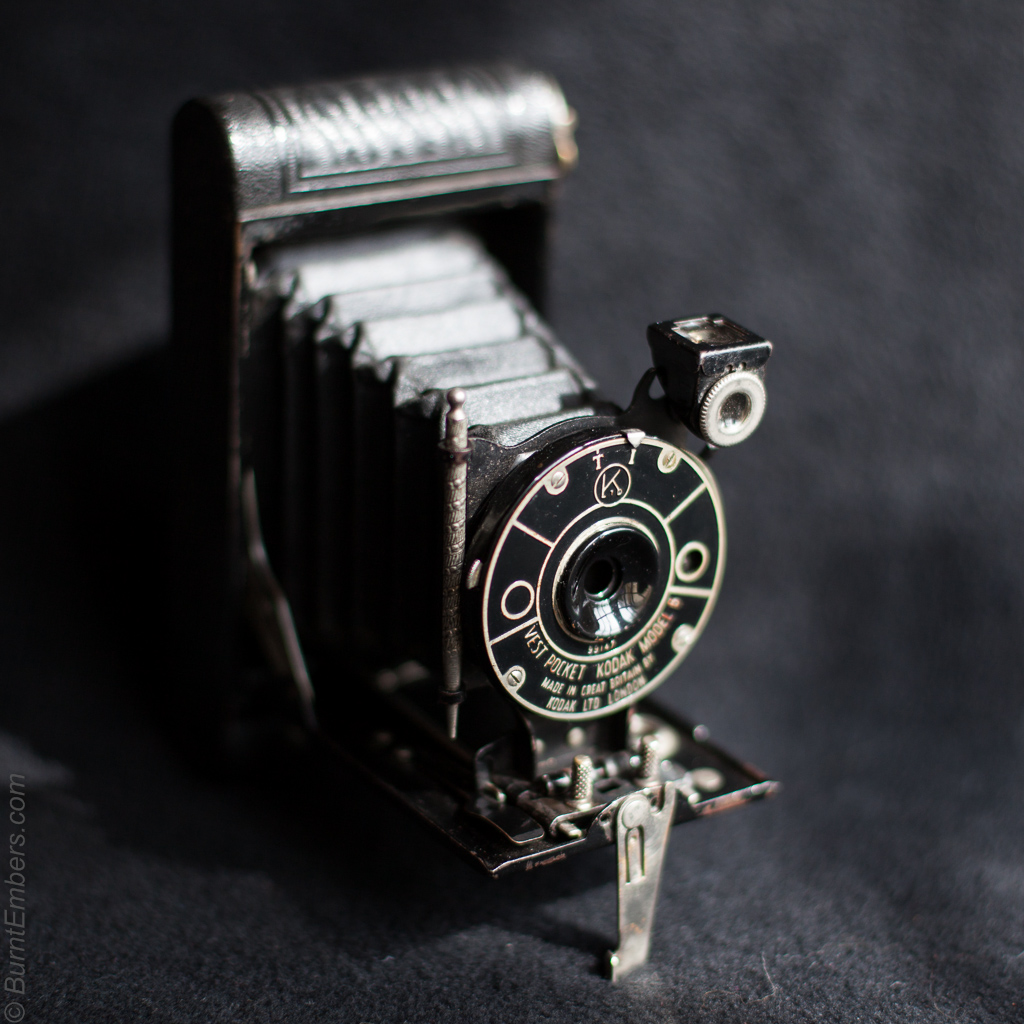

































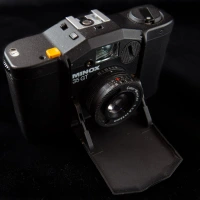
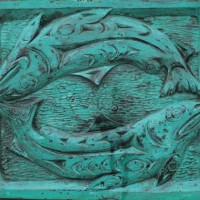

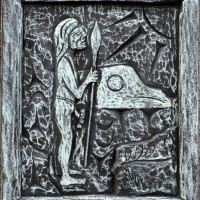
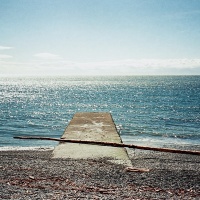
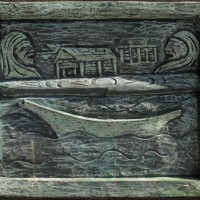
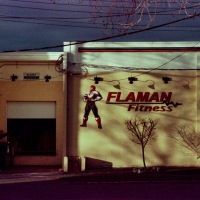




Pingback: VPK Kodak Vest Pocket Model B – Camera Go Camera
Pingback: Hello 52Rollers: Introducing Ehpem | 52 rolls
Pingback: Vest Pocket Results | burnt embers
This is an excellent study of a beautiful vintage object. I’m also very taken with the two-shot “animations” – a very useful tool which I’ve so far failed to get my head around…!
LikeLike
Thanks Mike – I do them in GIMP which is free, and there are some simple videos showing how to do animations. It is remarkably easy once the process is clear. Most important part is having images that are lined up properly to begin with. I have not yet tried layering, fitting them over each other and trimming so I get some slight movement of the whole picture as things like this move between shots.
LikeLike
This is an amazing series of photos – some of your best work, I think. Your photos show the craftsmanship on the camera, but more than that – they show your affection for the camera. Thank you for posting them.
(Also, I wanted to let you know that I smile every time I see your new header photo….)
LikeLike
Hey thanks Melinda – what a satisfying comment! It was pretty easy to photograph this camera – natural light from the window with no reflectors or anything. However, much of it was shot in live view and on my camera if you don’t get the right menu setting so that it is stills only, then it runs in P mode, which was the case for more than half of these images. Many are consequently up around 6000ISO, which I would not normally shoot at. Still, they came out OK and much as I like the camera, and photographing it, I was not about to reshoot at a lower ISO.
I like that header photo too – it is like my grand daughter is watching everything that is going on in my blog. I have to remember to keep it clean!
LikeLike
That is truly a gorgeous camera, even the stylus is beautiful! What a lovely gift and how exciting to be able to find the right film. I look forward to your images, Ehpem. I love the animations!
LikeLike
Hi Karen – thanks so much. It is gorgeous isn’t it? The texture on the leather surface (I assume it is leather), the little details, all are just right. And this was pretty much the cheapest in the line of Kodak fold out cameras, and yet they still took this much care. I will be posting images once I have them, and have them scanned. Should be fun. If it works.
LikeLike
Looks like a fun camera. I can’t wait to see what your produce.
LikeLike
Thanks Ben – I am getting to that stage too! I took 5 shots today. These kinds of cameras, with short rolls of hard to find film, and tricky shooting parameters, sure teach parsimony and forethought. Which is a very good thing to be reminded of even when shooting digital.
LikeLike
Nice! I have an earlier Autographic VP camera. Shot a few rolls of film in it. Was fun to shoot. I made a simple wire clip on “sport finder” for mine because it was pretty impossible to frame a shot using the “brilliant view finder.”
LikeLike
Hi Mark. I was shooting with it today, for the first time. Even though I took apart the “brilliant view finder” and cleaned it thoroughly, it was anything but brilliant so I know what you mean. I could use it though, just not with a great deal of precision. I will continue on with it as is and see how the film turns out. I expect that this may be the only roll that I put through the camera. But, if I want to shoot more, I may need some kind of adaptation to make it easier to sight through.
LikeLike
Can’t wait to see your photos!
LikeLike
Thanks Mark. I have a weekend wait for the roll of film to be processed. I get it on Tuesday, then I have to make a negative holder the right size for my scanner (I would rather do that with negs in hand so I can be sure of the size), then I can scan and show them to everybody. If they work out at all.
LikeLike
Such an interesting post and I love the animated shots! What a beautiful little camera 🙂
LikeLike
Thanks Lisa! Animations can be very good for illustrating a point. Only of these really necessary, but it was too much fun to just stop at one!
LikeLike
Life is full of the most extraordinary coincidences. I’ve been going through some of my father’s old things that have sat in a series of boxes since about 1990. And one of the objects I’ve been looking at in the last few days is a No 1A Pocket Kodak camera – probably dates from the late 1920s, but I recall him using it in the early 1950s. It has a remarkable similarity to the one you are showing here. By the sound of it, it’s larger, but the same style of construction. What a small world it is sometimes!
LikeLike
Hi Andy, that is coincidence. Even more so because I was given three Kodak folding cameras, one of which was a Kodak 1A Junior with a rapid rectilinear lens which is very large – looks like it shoots negatives that are 7x11cm (2.5 x 4.25 inches), or nearly twice the size of the Vest Pocket. We don’t have any good idea as to where this camera came from – perhaps in the same shipment from England. The bellows on the 1A Junior are shot, or at least look as if they are, and I am not sure if film (116/616?) can be bought anymore for it.
This list (http://bit.ly/1luVliH) has the manufacturing dates for different Kodak cameras. It looks like the 1A models of different kinds went out of production in the teens, with the autographic models surviving into the early 20s. You can probably find a manual for yours here: http://bit.ly/1hicvMx.
The third camera I was given is a Kodak Junior six-20 – it was my mother’s which she used for particular purposes into the 1970s or early 1980s. It still has a roll of Verichrome Pan film in it! I will be finishing that roll once I come to grips with how these work by using the Vest Pocket model a bit (and that will probably date the last time she used it too). I think this is probably the best of the three cameras, likely has the best optics, and is in good condition, also it can use 120 film that is still widely available.
LikeLike
Great essay on this old camera. It would be fun to find identify some photos it took.
LikeLike
Hi Richard – it would be fun indeed. I think that often the images were printed without the autographic notes showing, or they were trimmed off after printing and transferred by hand onto the photo album pages. Therefore, it is most likely that the negatives would be needed, and they seem to survive a lot less frequently than prints. It is a bit of a long shot I expect.
LikeLike
This is fascinating, ephem! Your photos are beautiful portraits of this amazing little camera, and I can’t wait to see the photos that it produces. Complete with autographic notes, of course.
LikeLike
Hi Vicki, I am eager to see what it can do as well, but there won’t be any old-style autographic notes as the film specially made for that purpose has been out of production for more than 80 years! Maybe I can add something to the exif data that will be a suitable substitute, but will have to figure out how to get that to show.
LikeLike
What a fabulous gift to be given! Even if it didn’t work anymore, I’d be happy to just look at this thing and take pictures of it!
LikeLike
Thank you Kiki. It is a great gift. I wish I knew for sure the history of the camera, and could assign some images directly to it. Perhaps some of my English relatives will see this and weigh in.
LikeLike
Beautiful post, I love the movement in some images.
LikeLike
Thank you ctteodorico, and welcome to my blog – I am enjoying browsing your blog, and your blipfoto site as well.
I had fun making those animations – it seems a good use for them. I need to learn how to align images and crop them so that there is less overall movement, though that does have a certain charm as well.
LikeLike
I have one of these but it looks much smarter in your pics than in real life!
LikeLike
Thank you Katherine! I agree – the light from the window was just right and mine too looks better in these photographs than in the hand.
LikeLike